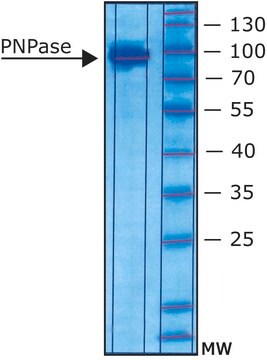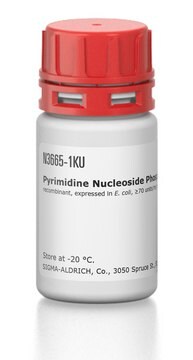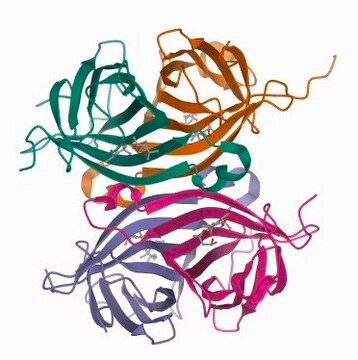N1290
Polynucleotide phosphorylase human
Sinônimo(s):
Polyribonucleotide nucleotidyltransferase
Faça loginpara ver os preços organizacionais e de contrato
About This Item
Número MDL:
Código UNSPSC:
12352204
NACRES:
NA.54
Produtos recomendados
recombinante
expressed in E. coli
Formulário
solution
enzyme activity
≥20 units/mg protein
peso molecular
~90 kDa
concentração
400-600 μg/mL protein
Condições de expedição
dry ice
temperatura de armazenamento
−70°C
Ações bioquímicas/fisiológicas
Polynucleotide phosphorylase (PNPase) is a bifunctional enzyme with a phosphorolytic 3′ to 5′ exoribonuclease activity and a 3′-terminal oligonucleotide polymerase activity. It is also involved in mRNA processing and degradation in bacteria, plants, and humans.
forma física
supplied as a solution in 20 mM HEPES buffer, pH 7.9, with 0.1 mM EDTA, 2 mM DTT, 12.5 mM MgCl2, ~130 mM KCl, and 20% (w/v) glycerol.
Código de classe de armazenamento
12 - Non Combustible Liquids
Classe de risco de água (WGK)
WGK 1
Ponto de fulgor (°F)
Not applicable
Ponto de fulgor (°C)
Not applicable
Escolha uma das versões mais recentes:
Certificados de análise (COA)
Lot/Batch Number
Não está vendo a versão correta?
Se precisar de uma versão específica, você pode procurar um certificado específico pelo número do lote ou da remessa.
Já possui este produto?
Encontre a documentação dos produtos que você adquiriu recentemente na biblioteca de documentos.
Lukasz S Borowski et al.
Biochimica et biophysica acta, 1797(6-7), 1066-1070 (2010-02-02)
Protein complexes responsible for RNA degradation play important role in three key aspects of RNA metabolism: they control stability of physiologically functional transcripts, remove the unnecessary RNA processing intermediates and destroy aberrantly formed RNAs. In mitochondria the post-transcriptional events seem
Victoria Portnoy et al.
RNA (New York, N.Y.), 14(2), 297-309 (2007-12-18)
PNPase is a major exoribonuclease that plays an important role in the degradation, processing, and polyadenylation of RNA in prokaryotes and organelles. This phosphorolytic processive enzyme uses inorganic phosphate and nucleotide diphosphate for degradation and polymerization activities, respectively. Its structure
Hsiao-Wen Chen et al.
Molecular and cellular biology, 26(22), 8475-8487 (2006-09-13)
We recently identified polynucleotide phosphorylase (PNPase) as a potential binding partner for the TCL1 oncoprotein. Mammalian PNPase exhibits exoribonuclease and poly(A) polymerase activities, and PNPase overexpression inhibits cell growth, induces apoptosis, and stimulates proinflammatory cytokine production. A physiologic connection for
Takashi Nagaike et al.
The Journal of biological chemistry, 280(20), 19721-19727 (2005-03-17)
Mammalian mitochondrial (mt) mRNAs have short poly(A) tails at their 3' termini that are post-transcriptionally synthesized by mt poly(A) polymerase (PAP). The polyadenylation of mt mRNAs is known to be a key process needed to create UAA stop codons that
Magdalena Leszczyniecka et al.
Proceedings of the National Academy of Sciences of the United States of America, 99(26), 16636-16641 (2002-12-11)
Terminal differentiation and cellular senescence display common properties including irreversible growth arrest. To define the molecular and ultimately the biochemical basis of the complex physiological changes associated with terminal differentiation and senescence, an overlapping-pathway screen was used to identify genes
Nossa equipe de cientistas tem experiência em todas as áreas de pesquisa, incluindo Life Sciences, ciência de materiais, síntese química, cromatografia, química analítica e muitas outras.
Entre em contato com a assistência técnica







